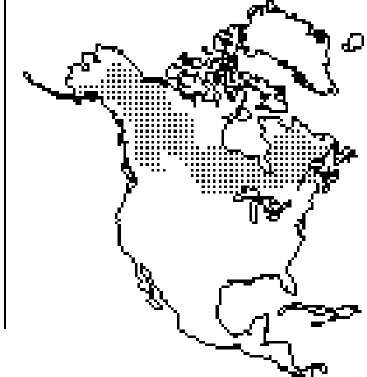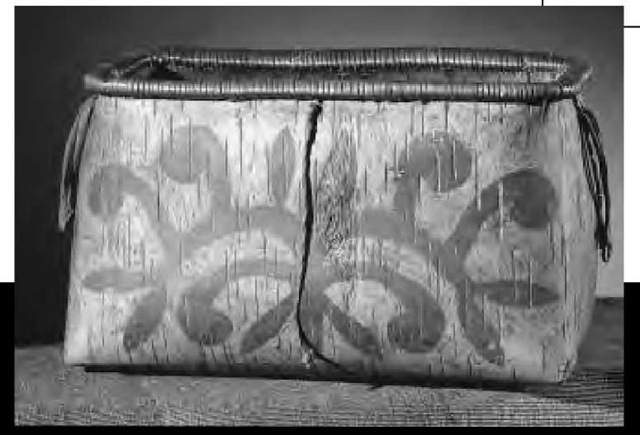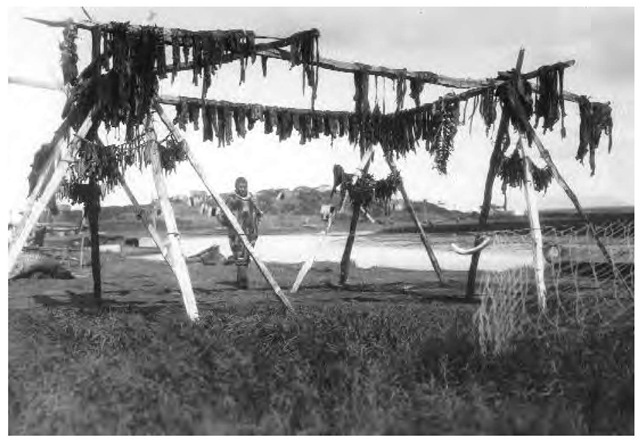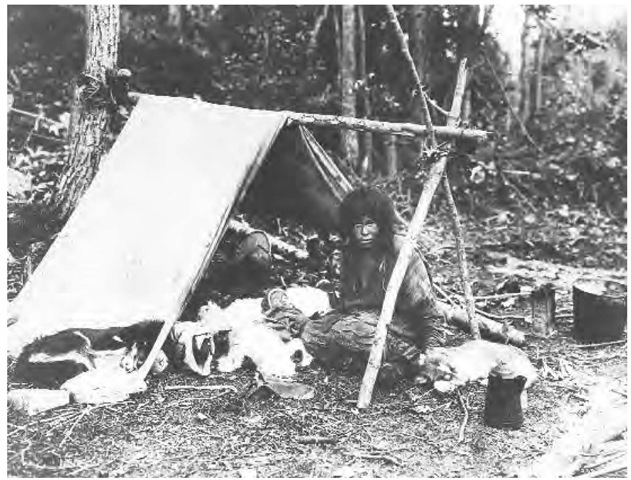The vast Subarctic region stretches from the Atlantic Ocean in the east to the Rocky Mountains and the Alaska coast in the west and from the northern Great Lakes region and Great Plains to the tundra. Over two million square miles in area, the Subarctic is commonly divided into different geological zones, such as Canadian Shield (Hudson Bay and Mackenzie River lowlands), Cordillera (northern Rocky Mountain region), Alaska Plateau (central interior Alaska, including major river drainages), and Alaska Coast (primarily Cook Inlet and Copper River).
The boreal forest is the region’s chief distinguishing physiographic feature. With the exceptions of birch and aspen, most trees, such as spruce, pine, fir, and tamarack, are conifers. There are thousands of streams and freshwater lakes, including Lake Winnipeg, Great Bear Lake, and Great Slave Lake, as well as Hudson Bay and coasts on two oceans. Low hills and rock outcroppings characterize much of the east. High mountains with glaciers, as well as plains, mark the far west. Major rivers include the Mackenzie, Peace, Churchill, Yukon, and Athabaska.
Despite its size and the variety of physical features, much of the region can be forbidding. Its continental climate is characterized by short, mild-to-hot summers (up to 38° Celsius/100° Fahrenheit) and long, bitterly cold winters (down to at least -38° Celsius/-100° Fahrenheit). Precipitation is generally low, except along the Alaska coast and in some mountain regions, and it falls mainly as snow. The short spring is marked by ice breakup and snow melt out as well as plagues of mosquitoes, black flies, and other insects. Travel is limited in spring and also during fall freeze up. Food, mainly in the form of game and fish, could be plentiful, but starvation was also a regular feature of life in the Subarctic.
The sheer difficulty of living in the Subarctic accounts for its low aboriginal population. Probably no more than 100,000 people ever lived in the region at any one time. These hunter-gatherers spoke Athapaskan (mostly in the west) and Algonquian languages. Some southern groups blend almost imperceptibly into other cultural regions. For instance, the Anishinabe (Northern Ojibwa and Salteaux) are often discussed with Northeast Indians, whereas Carrier and Chilcotin are sometimes grouped in the Plateau region. Alternatively, people such as the Shuswap, discussed in this topic as Plateau Indians, are occasionally placed in the Subarctic region.
The arrival of non-natives—around 1500 in the extreme southeast and not until the nineteenth century in some western interior regions—affected Indian groups in different ways. Like Native Americans everywhere, however, all suffered sharp population losses. Most Subarctic Indians today mix Christianity, to different degrees, with significant elements of traditional belief and spirituality. Acculturation levels vary widely. Many people continue to hunt, fish, and trap, although giant hydroelectric and mining projects both claim and pollute the land. Contemporary Subarctic Indians still fight to regain their sovereignty. As people for whom traditions remain vital, they struggle to redefine their identities in the face of a global economy and culture that are increasingly part of their lives.
The first people entered the Subarctic region about the time that the frozen Bering Straits provided a land corridor between Asia and North America. This migration occurred at least 12,000 years ago but possibly as long as 25,000 or more years ago. Shallow lakes covered much of today’s lowlands, and glacial ice persisted in some areas up to 7,000 years ago. On the other hand, southern grasslands and the boreal forest extended farther north than they do today, as did animal species like bison and caribou. Some of the earliest northwestern people used tools like stone microblades, which were straight-sided and flat. They probably had spears, snares, snowshoes, and canoes but not the bow and arrow.
Athapaskan speakers descend from a Northern Archaic culture that existed at least 6,000 years ago. About the same time, and over the next several thousand years, the Shield culture diverged in the east, as far as Labrador, from more ancient ones. Local technology changed only slowly until the first non-native influences arrived. People acquired the bow and arrow around 1,000 or perhaps 2,000 years ago. The Taltheilei tradition began about 2,600 years ago from Great Bear Lake to Lake Athabaska and the Churchill River.
The Laurel Culture of Manitoba and northern Ontario, characterized in part by a ceramic tradition acquired from the south, lasted from about 1000 B.C.E. to about 800 C.E. Laurel pots were coiled, impressed, incised, and then fired. Some were later painted red. Some people living in the extreme south built mounds over their dead. Later prehistoric cultures included the Selkirk and Blackduck Cree, who also made pottery, beginning about 1,500 years ago. Selkirk ceramics are fabric impressed.
Names of contemporary Indian tribes bear little relationship to aboriginal nomenclature or political organization. In general, the basic unit was the local group, which generally consisted of from 10 to 20 related people but could be up to 75 or so. Membership was fluid and nonbinding, in deference both to values of autonomy and the need for flexibility in a difficult environment. Leadership was extremely informal and nonauthoritarian, with the exception of those groups most influenced by Northwest Coast cultures. When conditions permitted, probably not quite every summer, local groups might come together as loosely constructed regional bands of several hundred people to socialize and renew family ties.
In parts of the Cordillera, the memorial potlatch was a major ceremonial event. Consisting of public celebration as well as ritual display of crests and distribution of wealth, it was used to enhance rank when the fur trade generated greater wealth. Even so, chiefs were recognized only among their own clan or lineage. Despite official opposition by non-natives in the nineteenth century, potlatches actually grew in importance.
Warfare was generally a local matter. Although some groups sought women, most people fought over revenge for trespass or a prior blood transgression. Warfare was better developed in the far west than in other regions. Weapons there included antler clubs soaked in grease, armor, and spears as well as the bow and arrow. Nowhere did large, regional groups conduct full-scale wars.
Trade, which occurred at least as early as 10,000 years ago, provided a peaceful reason for travel and human interaction. Both goods and services, such as curing, were exchanged. Most material trade was in animal products. Northwest Coast peoples and Cordillerans exchanged animal products for marine products, including dentalium, salmon, and eulachon oil. Other trade goods included raw materials, such as birch bark, obsidian, copper, fused tuff, and manufactured goods, such as birch-bark containers, snowshoes, baskets, and clothing. Ancient trade also existed between Alaska and Asia. Except for the western Cordillera and Alaska Plateau, the existence of large, multitribal trade fairs remains a matter of speculation.
In this 1914 photo by Edward S. Curtis, strips of walrus and whale meat are shown hanging to dry after being smoked. Curtis’s photographs often reflected his twin goals of documenting the aboriginal way of life and creating "art."
Religious conceptions and ceremonial innovation varied considerably throughout the Subarctic. Nearly everyone believed in the existence of various natural powers. In order to tap into those powers, they fasted, dreamed, and/or held vigils to attract guardian spirits, mainly animal related, that might provide individual assistance. Respect for all nature, especially animals and particularly food animals, was a key part of Subarctic religion and ceremonialism, as was a belief in reincarnation. Most groups had also formulated rich mythologies as well as conceptions of malevolent supernatural beings that were greatly to be feared.
Illness was generally associated with soul loss. Cures might be effected by shamans, men and/or women with particularly strong spirit powers. Shamans were also said to be able to find lost things, including game, and to foretell the future. Their methods included scapulimancy, or looking at burn marks on an animal’s shoulder blade, and communing with spirits in a shaking tent. Most people believed that shamans could also use their powers for ill.
Since the entire Subarctic is north of the limits of native agriculture, people fed themselves by hunting, fishing, and, to a variable extent, gathering berries and other plant foods. Unfortunately, many groups depended on a single species, such as moose or caribou, for the bulk of their diet. When game was plentiful this practice was not a problem, but since the population of key resources was subject to natural fluctuation, groups regularly suffered hunger and even starvation.
Caribou were often captured by means of large surrounds or corrals or were driven through fence systems into lakes, where they were shot. They were also stalked and snared, as were moose. In the extreme north, people brought firewood, tent stakes, and canoes out onto the Barren Grounds for the summer caribou hunt, thanks mainly to the strength and endurance of women. Fowl and smaller animals, such as hare, marmot, beaver, and muskrat, were also snared and shot. People caught fish with a variety of devices, depending on location, such as nets, traps, gaffs, hooks, and weirs. Coastal people relied also on sea mammals and shellfish. In the west, some groups, such as the Beaver, even hunted buffalo.
Subarctic natives generally used animal parts as well as wood, bark, roots, and stone (including, in some areas, native copper) as their raw materials. With a limited local tool kit, many groups borrowed liberally from neighbors, such as Northwest Coast Indians or Inuit. One key item, especially in the west, was babiche, or semisoftened rawhide. This material was used for everything from snares to netting to bowstrings. Although overland travel was preferred, the people did build bark canoes and, in some cases, moose-hide boats. They used bark, skin, or woven roots to make containers, including those that held water. In a successful effort to encourage certain microhabitats and environments, many Subarctic Indians also practiced controlled burning.
Shelter was remarkably homogeneous across the region. The most common type was the domed or conical lodge, consisting of poles covered with skins, boughs, or birch bark. Groups nearest Northwest Coast people built plank houses. Some northwestern groups built frame houses partially below the earth, using earth and moss as insulating materials, as well as bark-covered rectangular houses at fishing camps. Some groups used shelters with a double A-ridgepole framework and containing multiple fires. Drying racks, sweat houses, caches, menstrual huts, and other structures were also commonly built.
Women generally made the clothing, which came from moose, caribou, hare, or other skins, with trim of beaver or other fur. Winter items, such as parkas, hats, and mittens, were also made of fur. Hides were tanned, generally with brains or grease, and often dehaired. Many people wore leggings with attached moccasins. Clothing was variously decorated with fringe, paint, quills, claws, or down.
The general status of women varied according to local custom. Female infanticide was not unknown throughout much of the region. Women were generally subject to menstrual taboos, some quite rigorous. Some served essentially as pack animals while getting little to eat. On the other hand, benefiting from a general tradition of autonomy, some also attained both authority and power.
In this harsh climate, generosity and good humor were two key virtues. In most societies, newly married men were required to live with and serve their in-laws for a period of at least a year before establishing their own households. Descent was generally matrilineal, although this custom was neither important nor rigorously followed. Corpses were often cremated.
Indians living in the extreme east and southeast of the region may have encountered Vikings a thousand years ago. They certainly met Basques, Bretons, and other Europeans fishing in the Gulf of St. Lawrence around 1500. Indians of the interior Cordillera, however, did not actually encounter non-natives until the early to mid-nineteenth century, although items of non-native manufacture had reached them much earlier through aboriginal trade networks. The fur trade became the basis of interracial relations. The Hudson’s Bay Company was chartered in 1670 and the Northwest Company in 1787. The two merged in 1821. Russian trade forts were founded in Alaska as early as the 1780s.
Throughout the region, the non-native presence profoundly affected Indians in several ways. Hitherto unknown diseases, such as smallpox, measles, scarlet fever, influenza, and syphilis, not to mention alcoholism and alcohol-related deaths, reduced populations by up to 90 percent or even 100 percent in some locations. Local economies slowly changed from subsistence to trade based, resulting in a decline in native manufacture and an accompanying loss of knowledge. A few more isolated groups rejected the attraction of trade, preferring to maintain their traditional patterns.
Another result of the non-native presence was increased hunger and poor nutrition, as big game dwindled in numbers and items such as white flour and refined sugar increasingly replaced healthy traditional foods. Social and political structures began to change as well in response to the demands of fur traders and, later, non-native governments. Especially in the nineteenth century, missionaries worked to eliminate native customs and beliefs and ultimately Christianized most Subarctic Indians, although, among many groups, traditional beliefs coexist with Christianity to varying degrees. Generosity, reciprocity, and autonomy were increasingly threatened by individualism and dependence.
An Ahtna woman and her child. The most common type of subarctic shelter was the domed or conical lodge, consisting of poles covered with skins, boughs, or birch bark. The general status of women varied according to local custom. Some served essentially as pack animals while getting little to eat.
Among the first actions of the Dominion of Canada (1867) was instituting federal control over First Nations (as Indian bands are called in Canada). Under the various Indian Acts, the Canadian government required the election of band leaders; controlled Indian finances; undermined Indian religion and spirituality; and regulated Indians’ movement, mobility, organizing abilities, and their very identity (for instance, Indian women who married non-natives officially lost their Indian "status"). The Indian departments were highly corrupt. Indian land was often alienated by methods that were quasi-legal at best.
The Canadian government signed 11 "numbered" treaties with Indian groups (with the general exception of those living in British Columbia and Yukon Territory) from 1871 to 1921. A common feature was the exchange of land rights for payments and other benefits. Informal groups of Indians accustomed to living near trading posts were officially recorded as fixed, legal bands with chiefs legitimized by the Canadian and U.S. governments. The treaties generally ignored the rights of Metis, or descendants of Indian-non-native unions. The federal and certain provincial governments fought over jurisdictional issues until 1927. Since the United States stopped treating with Indian groups after 1871, the question of land ownership in Alaska remained even nominally unresolved until well after the end of World War II.
By 1900, the numbers of missionaries, construction crews, miners, and other adventurers continued to grow. Railroads and steamboats reached isolated areas. Even groups that retained a nomadic lifestyle tended to congregate around the trading posts for Christian holidays. Indian groups began to use dog teams for winter transport. That development made trapping more efficient, but it also contributed to the sedentary lifestyle by increasing the need for fish (used as dog food). Although still few in number, there were growing job opportunities in industries such as transportation, mining, and forestry.
The 1940s were a watershed in Subarctic native history. The Alaska Highway was completed in 1943. It changed life dramatically for many natives, not least by ushering in a period of severe epidemics. Air service—for example, for medical treatment—to towns and even large cities became widely available. Educational opportunities as well as wide-ranging health and social services increased markedly. About the same time, fur prices collapsed. Seasonal trading post communities turned into permanent villages and towns. Native populations, after generally reaching their nadir in the 1920s, began to grow.
The post-World War II era has also been characterized by the creation of giant mining and hydroelectric projects. Inevitably, the interests of corporations and people have clashed, and the results have been ambiguous at best. For instance, the James Bay and Northern Quebec Agreement of the mid-1970s allowed the massive flooding of Cree lands. Although the people gained unprecedented (for the modern era) control over their internal affairs, they have had to cope with an equally unprecedented loss of territory, widespread pollution, and promises that remain unfulfilled.
Farther west, a proposed pipeline through Indian land spurred heightened consciousness and political unity. The Dene Nation successfully resisted that project and continues to fight for political sovereignty. In Alaska, the Alaska Federation of Natives was founded in 1966. That group was instrumental in passing the 1971 Alaska Native Claims Settlement Act, in which natives traded aboriginal rights for land and money. The people also agreed to subsume their political identities into local and regional corporations, the latter of which have tended to become enmired in legal entanglements. Some villages have Indian Reorganization Act-style governments, whereas others are incorporated or have reservation status. The eleven contemporary Alaskan Athapaskan groups are Ahtena, Han, Holikachuk, Ingalik (Deg Hit’an), Koyukon, Kutchin (Gwich’in), Tanacross, Tanaina (Dena’ina), Tanana, Upper Kuskokwim, and Upper Tanana.
The debates over Quebec independence and related constitutional issues have provided First Nations with an opportunity to press even more strongly for self-government. In fact, this goal has been achieved to a significant extent. Since the 1970s, for instance, schools, including curricula, have come increasingly under the control of local Indian organizations. In the 1980s, sections of the Indian Act dealing with federal control of band membership were repealed. At least in theory, native self-governance is now also the goal of the Canadian government.
However, most federal policies are still taken without significant Indian input.
Today, some Subarctic Indians continue to trap, hunt, gather, and fish, although few remain long in the bush. Those who do often depend on snowmobiles and boats with outboard motors to get them where they need to go. Most live in towns and work for wages and/or receive government payments. Job opportunities remain limited. Many native languages survive, but despite efforts to slow or reverse the process, they are increasingly threatened. Electronic communication increasingly removes the younger generations from the world of their grandparents.
The statistical profile of Subarctic Indians shows high mortality rates, inadequate housing, health problems, and other ills. However, in many ways optimism and renewal are taking over. Native-owned businesses are on the rise. Substance-abuse programs are proliferating and are increasingly linked with successful and local social programs. Educational levels are rising sharply. On the crucial issue of sovereignty the people still have an uphill battle, but they are perhaps better prepared—and more willing— to wage that battle than they ever have been before.




